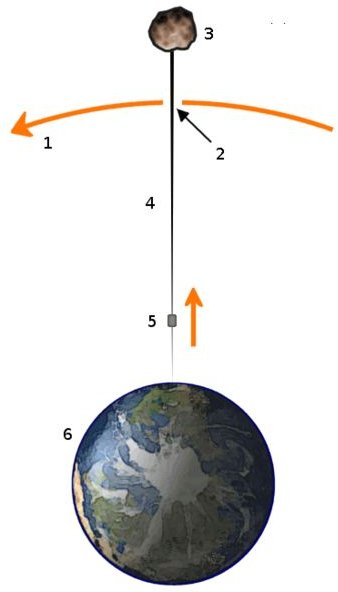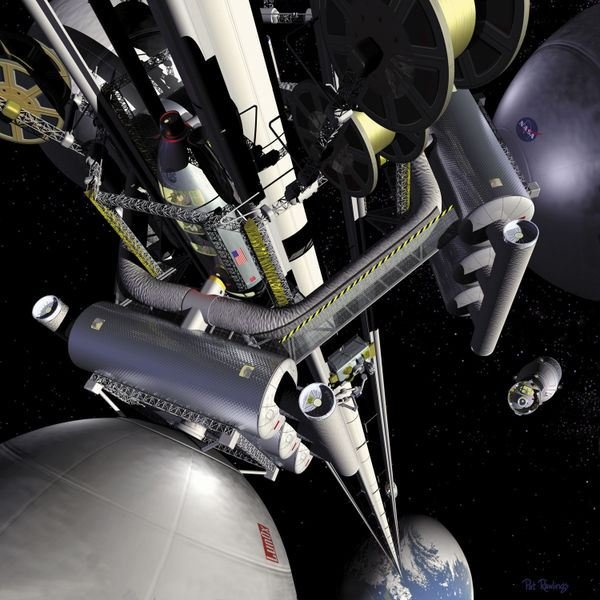How Does the NASA Space Elevator Work? Will the Space Elevator Plans Ever Become a Reality?
Early Concepts
The first space elevator would be assembled “about 50 years after everyone quits laughing”
Arthur C. Clarke (Science Fiction Author)
The space elevator concept was considered a science fiction and laughed at by many. But, today there has been some serious theories revolving around the construction of a “Sky Railroad” that can send payloads straight up for thousands of miles and help to promote space tourism. Before delving deep into the theory of how does the space elevator work, let’s go back in time to understand the roots of this innovative concept.
Ancient sacred Hindu texts presented a rough idea of a space elevator. Epics like the Ramayana reveal an account of Ravana’s dream to build a “ladder” from his earthly kingdom to the Moon’s surface. The Russian scientist Konstantin Tsiolkovski conceptualized the building of a “castle” orbiting Earth in geosynchronous orbit. The year was 1895 when Konstantin envisioned the Eiffel Tower in Paris attached to the “castle” with a spindle shaped thread.
The space elevator theory popped up again after 65 years when a Leningrad engineer named Yuri Artsutanov penned the first contemporary notions about space elevators. But, it was Arthur C. Clarke’s “Fountain of Paradise” that introduced this concept to a broader audience. His 1978 novel narrates the construction of a space elevator on a mythical Taprobane island (a fictional island with geographical characteristics similar to Sri Lanka).
Arthur C. Clarke’s space elevator concept was taken lightly by mainstream space technology geniuses as a mere science-fiction story. But, today space agencies like NASA and private enterprises like the Japan Space Elevator Association are thinking to build a “railroad to space” for a celestial joyride.
(Image, Right: Arthur C. Clarke, who envisioned communications satellites orbiting the earth in fixed positions. Will his space elevator concept ever turn into reality? Photo by Amy Marash Courtesy: https://commons.wikimedia.org/wiki/File:Clarke_sm.jpg )
How Does the Space Elevator Work?

A proposed structure aimed to transport payloads and people from Earth’s surface into space, the space elevator is also known as a space lift, space ladder or orbital tower. The structure consists of vehicles or carriages traveling along a long cable that can serve as a mass transportation system for moving payloads, power and people between Earth and space. The proposed long cable, or ribbons of synthetic material will extend from the Earth’s surface up to an altitude of 100,000 kilometers (62,000 miles).
To explain how does the space elevator work, recent theories suggest tensile structures, specifically tethers extending from our planet’s surface into space with a center of mass at GEO (geostationary earth orbit) 22,236 miles (35,786 km) above ground. Four or Five “elevator tracks” will allow robots or vehicles to travel at thousands of kilometers per-hour speeds. The construction of the space elevator is proposed to take place in a location near to the equator. This is because equatorial locations align properly with geostationary orbits.
(Image, Right: Artist’s impression of a Space Elevator, Courtesy: https://commons.wikimedia.org/wiki/File:Space_elevator_structural_diagram.png )
The Complications of Building a Space Elevator:
Before we comprehend how does the space elevator work, we should first understand the complications of building one. Building an orbital elevator will not be an easy task. Space elevators would require tethers that have to be ultra-strong and super lightweight. Current technology is not capable enough to manufacture strong as well as lightweight engineering materials. But, carbon nanotube-based materials can be the best tensile element in the design of tethers. Carbon nanotubes or CNT have theoretical tensile strengths of about 200 Giga Pascals. In simpler terms, CNTs are 100 times stronger than steel, but lightweight. In terms of tension, carbon nanotubes have strengths similar to diamond.
Another concern is fueling up the robot or electromagnetic vehicles to climb up and down. This can be solved with the help of power-beaming systems or laser beams that can keep the robots transporting payloads from Earth to space. The power beaming systems will be supplemented by solar energy.

NASA is planning to build a space elevator with the help of the above technologies. But, the project needs billions of dollars to build a first-of-its-kind elevator to space. While the NASA space elevator construction is projected to take shape in 200 years, private-sector enterprises are seriously thinking to build a space elevator in a couple of decades from now. Countries like Japan are confident in constructing an orbital tower with an amazing price tag slightly higher than 1 billion US dollars. Some private enterprises in Japan plan to construct a space elevator along with a space solar power system by 2030.
(Image, Left: Artist’s Idea about a Space Elevator, Courtesy: https://commons.wikimedia.org/wiki/File:Nasa_space_elev.jpg)
Conclusion
While people wonder how does the space elevator work and imagine its existence in the near future, it is also very important to ascertain its cost-effectiveness and other intricacies.
If a space elevator is built in the near future, just imagine how cost-effective it will be in deploying payloads. With current methods of deploying payloads costing around $3,000 to $60,000 a pound, the cost of carrying payload via robots would be less than $100 a pound! Moreover, a common man’s dream of travelling to space will come true. It will certainly open the roads to space tourism. Some proponents are even thinking of harnessing the benefits of space elevators for human exploration and colonization of Mars.
Prior to man’s success in the moon landing project, it was believed that man would never reach the moon’s surface. But, NASA proved it wrong. Maybe, the dream of building a space elevator will materialize in the near future. Keep your fingers crossed!
References
https://science.nasa.gov/headlines/y2000/ast07sep_1.htm
https://en.wikipedia.org/wiki/Space_elevator
https://cosmiclog.msnbc.msn.com/archive/2008/07/18/1206845.aspx
https://www.timesonline.co.uk/tol/news/uk/science/article4799369.ece
